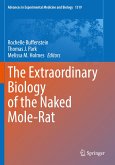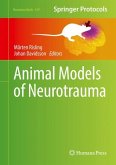The Extraordinary Biology of the Naked Mole-Rat
Herausgegeben:Buffenstein, Rochelle; Park, Thomas J.; Holmes, Melissa M.
The Extraordinary Biology of the Naked Mole-Rat
Herausgegeben:Buffenstein, Rochelle; Park, Thomas J.; Holmes, Melissa M.
- Gebundenes Buch
- Merkliste
- Auf die Merkliste
- Bewerten Bewerten
- Teilen
- Produkt teilen
- Produkterinnerung
- Produkterinnerung
This volume focuses on the huge advances in the last 25 years on the use of this animal model for biomedical research (cancer, heart disease and neurodegeneration), fundamental neuroscience and basic subterranean biology. In 2013, Science magazine named the naked mole-rat as the Vertebrate of the Year. This was partly due to research carried out documenting its extreme longevity, negligible senescence, and prolonged maintenance of cancer free, good health well into old age as well as seminal work on mechanisms involved in these processes, pain and hypoxia resistance. In addition to this…mehr
Andere Kunden interessierten sich auch für
![The Extraordinary Biology of the Naked Mole-Rat The Extraordinary Biology of the Naked Mole-Rat]() The Extraordinary Biology of the Naked Mole-Rat103,99 €
The Extraordinary Biology of the Naked Mole-Rat103,99 €![Rat Experimental Transplantation Surgery Rat Experimental Transplantation Surgery]() Rat Experimental Transplantation Surgery74,99 €
Rat Experimental Transplantation Surgery74,99 €![Advances in Comparative Immunology Advances in Comparative Immunology]() Advances in Comparative Immunology148,99 €
Advances in Comparative Immunology148,99 €![Advances in Comparative Immunology Advances in Comparative Immunology]() Advances in Comparative Immunology217,99 €
Advances in Comparative Immunology217,99 €![Mouse as a Model Organism Mouse as a Model Organism]() Mouse as a Model Organism110,99 €
Mouse as a Model Organism110,99 €![Animal Models of Neurotrauma Animal Models of Neurotrauma]() Animal Models of Neurotrauma110,99 €
Animal Models of Neurotrauma110,99 €![Animal Models of Acute Neurological Injuries II Animal Models of Acute Neurological Injuries II]() Animal Models of Acute Neurological Injuries II82,99 €
Animal Models of Acute Neurological Injuries II82,99 €-
-
-
This volume focuses on the huge advances in the last 25 years on the use of this animal model for biomedical research (cancer, heart disease and neurodegeneration), fundamental neuroscience and basic subterranean biology. In 2013, Science magazine named the naked mole-rat as the Vertebrate of the Year. This was partly due to research carried out documenting its extreme longevity, negligible senescence, and prolonged maintenance of cancer free, good health well into old age as well as seminal work on mechanisms involved in these processes, pain and hypoxia resistance. In addition to this research focus on longevity and chronic diseases such as cancer and cardiovascular disease, the naked mole-rat has also made a substantial contribution to the fields of ecophysiology, neuroscience and behavior. With international contributions, this book provides a valuable text for zoological students, behavioral scientists and biomedical researchers.
Produktdetails
- Produktdetails
- Advances in Experimental Medicine and Biology 1319
- Verlag: Springer / Springer International Publishing / Springer, Berlin
- Artikelnr. des Verlages: 978-3-030-65942-4
- 1st ed. 2021
- Seitenzahl: 460
- Erscheinungstermin: 24. August 2021
- Englisch
- Abmessung: 260mm x 183mm x 29mm
- Gewicht: 1159g
- ISBN-13: 9783030659424
- ISBN-10: 3030659429
- Artikelnr.: 60544026
- Advances in Experimental Medicine and Biology 1319
- Verlag: Springer / Springer International Publishing / Springer, Berlin
- Artikelnr. des Verlages: 978-3-030-65942-4
- 1st ed. 2021
- Seitenzahl: 460
- Erscheinungstermin: 24. August 2021
- Englisch
- Abmessung: 260mm x 183mm x 29mm
- Gewicht: 1159g
- ISBN-13: 9783030659424
- ISBN-10: 3030659429
- Artikelnr.: 60544026
Dr. Rochelle (Shelley) Buffenstein is a Senior Principal Investigator at Calico Life Sciences LLC, a company dedicated to harnessing advanced technologies to understand the basic biology of aging. She is also an adjunct professor in the Department of Pharmacology at the University of Texas Health Science Center at San Antonio. Shelley has published more than 180 publications, and has been recognized with several awards, including a Breakthroughs in Gerontology award from the Glenn Foundation, an Ellison Medical Foundation Senior scholar award, the ADPS Longevity Award and the American Aging Association Denham Harman Lifetime Achievement award. Shelley started off her career as an ecophysiologist studying a diverse suite of species that inhabit extremely challenging environments, undertaking her PhD under the mentorship of Jenny Jarvis on the ecophysiology of desert rodents. While a student at the University of Cape Town, she accompanied Jenny Jarvis on various field trips to Kenya, Namibia and within South Africa to undertake field work on mole-rats and other rodents. A key focus of her research over the last 30 years has been the physiology, endocrinology and aging biology of the exceptionally long-lived (~35 years) naked mole-rat and the molecular mechanisms these mouse-size rodents employ to maintain good health, reproductive fitness and cognition well into their third decade. Working with a species that hasn't read the textbook of how to behave like a mammal has been an incredibly rewarding experience, forging terrific friendships through collaboration and intriguing scientific challenges. Thomas Park is a professor of Biological Sciences and Neuroscience at the University of Illinois at Chicago. His graduate training was in behavioral assessments of sound perception in birds and gerbils. His post-doctoral training was in electrophysiology of auditory brain regions in awake bats. After taking a position at the University of Illinois at Chicago, he obtained a colony of naked mole-rats from Professor Jenny Jarvis with the idea of studying their hearing. But the naked mole-rats spoke to him and expanded his research focus and his life. Now, in addition to hearing, he focuses on amazing adaptations that naked mole-rats have for tolerating oxygen deprivation and high concentrations of carbon dioxide. Working with naked mole-rats has also opened the door for wonderful collaborations and lifelong friendships. Melissa Holmes is an associate professor of Psychology at the University of Toronto Mississauga. Her doctoral training was in sexual differentiation and adult plasticity in green anoles. Working with Professor Nancy Forger, her post-doctoral training was in sex and status effects on neural plasticity in naked mole-rats. When starting her position at the University of Toronto, she inherited a colony of naked mole-rats from Professor Bruce Goldman, to continue their work on behavioral neuroendocrinology and adult neural plasticity. She continues to use multi- and inter-disciplinary approaches to primarily focus on the remarkable social and reproductive adaptations in naked mole-rats as well as contribute to a variety of diverse research questions through many successful and rewarding collaborative projects.
Dedication.- About the editors.- Preface (Jarvis JUM).- Chapter 1. Social evolution in African mole-rats - a comparative overview (Faulkes CG & Bennett NC).- Chapter 2. Social behavior in naked mole-rats: individual differences in phenotype and proximate mechanisms of mammalian eusociality (Holmes MM & Goldman BD).- Chapter 3. Neuropeptidergic and neuroendocrine systems underlying eusociality and the concomitant social regulation of reproduction in naked mole-rats: a comparative approach (Coen CW, Bennett N, Holmes MM, & Faulkes CG).- Chapter 4. Adult neural plasticity in naked mole-rats: implications of fossoriality, longevity and sociality on the brain's capacity for change (Mooney SJ, Forger NG, & Holmes MM).- Chapter 5. Sensory Systems of the African Naked Mole-Rat (Vice EN, Lagestee S, Browe BM, Deb D, Smith ESJ, Park TJ).- Chapter 6. Hearing and vocalizations in the naked mole-rat (Barker AJ, Koch, U, Lewin GR, Pyott, SJ).- Chapter 7. The somatosensory world of the African naked mole-rat (Lewin GR, Smith ESJ, Reznick J, Debus K, Barker A, and Park TJ).- Chapter 8. The idiosyncratic physiological traits of the naked mole-rat; a resilient animal model of aging, longevity, and healthspan (Buffenstein R and Craft W).- Chapter 9. African Naked Mole-Rats Demonstrate Extreme Tolerance to Hypoxia and Hypercapnia (Park TJ, Smith ESJ, Reznick J, Bennett NC, Applegate DT, Larson J, Lewin GR).- Chapter 10. A sweet story of metabolic innovation in the naked mole-rat (Reznick J, Park TJ, and Lewin GR).- Chapter 11. Insights into the molecular basis of genome stability and pristine proteostasis in naked mole-rats (Narayan V, McMahon M, O'Brien J, McAllister F and Buffenstein R).- Chapter 12. The Unusual Immune System of the Naked Mole-Rat (Lin TD and Buffenstein R).- Chapter 13.- Induced Pluripotent Stem Cells from Cancer-Resistant Naked Mole-rats (Miura. K, Oiwa Y, and Kawamura Y).- Chapter 14. Naked mole-rats: resistant to developing cancer or good at avoiding it? (HadiF, Smith ESJ and Khaled WT).- Chapter 15. Spontaneous Disease and Pathology of Naked Mole-rats (Delaney MA, Imai DM, Buffenstein R).- Chapter 16. Managed Care of Naked Mole-rats (Smith M, and Buffenstein¬ R).- Chapter 17. Some exciting future directions for work on naked mole-rats (Smith ESJ, ParkTJ, Holmes MM and Buffenstein R).
Dedication.- About the editors.- Preface (Jarvis JUM).- Chapter 1. Social evolution in African mole-rats - a comparative overview (Faulkes CG & Bennett NC).- Chapter 2. Social behavior in naked mole-rats: individual differences in phenotype and proximate mechanisms of mammalian eusociality (Holmes MM & Goldman BD).- Chapter 3. Neuropeptidergic and neuroendocrine systems underlying eusociality and the concomitant social regulation of reproduction in naked mole-rats: a comparative approach (Coen CW, Bennett N, Holmes MM, & Faulkes CG).- Chapter 4. Adult neural plasticity in naked mole-rats: implications of fossoriality, longevity and sociality on the brain's capacity for change (Mooney SJ, Forger NG, & Holmes MM).- Chapter 5. Sensory Systems of the African Naked Mole-Rat (Vice EN, Lagestee S, Browe BM, Deb D, Smith ESJ, Park TJ).- Chapter 6. Hearing and vocalizations in the naked mole-rat (Barker AJ, Koch, U, Lewin GR, Pyott, SJ).- Chapter 7. The somatosensory world of the African naked mole-rat (Lewin GR, Smith ESJ, Reznick J, Debus K, Barker A, and Park TJ).- Chapter 8. The idiosyncratic physiological traits of the naked mole-rat; a resilient animal model of aging, longevity, and healthspan (Buffenstein R and Craft W).- Chapter 9. African Naked Mole-Rats Demonstrate Extreme Tolerance to Hypoxia and Hypercapnia (Park TJ, Smith ESJ, Reznick J, Bennett NC, Applegate DT, Larson J, Lewin GR).- Chapter 10. A sweet story of metabolic innovation in the naked mole-rat (Reznick J, Park TJ, and Lewin GR).- Chapter 11. Insights into the molecular basis of genome stability and pristine proteostasis in naked mole-rats (Narayan V, McMahon M, O'Brien J, McAllister F and Buffenstein R).- Chapter 12. The Unusual Immune System of the Naked Mole-Rat (Lin TD and Buffenstein R).- Chapter 13.- Induced Pluripotent Stem Cells from Cancer-Resistant Naked Mole-rats (Miura. K, Oiwa Y, and Kawamura Y).- Chapter 14. Naked mole-rats: resistant to developing cancer or good at avoiding it? (HadiF, Smith ESJ and Khaled WT).- Chapter 15. Spontaneous Disease and Pathology of Naked Mole-rats (Delaney MA, Imai DM, Buffenstein R).- Chapter 16. Managed Care of Naked Mole-rats (Smith M, and Buffenstein¬ R).- Chapter 17. Some exciting future directions for work on naked mole-rats (Smith ESJ, ParkTJ, Holmes MM and Buffenstein R).








